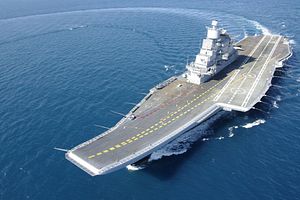India is pushing hard on its carrier fleet, but does it have a good sense of where it’s going?
Reports have emerged that India’s second indigenously built carrier, expected to be the third carrier to enter service in the next two decades, may utilize nuclear propulsion. This is alongside a set of other innovations that the Vishal might adopt, including EMALS catapult technology (possibly developed in association with the United States). India has taken strides on nuclear propulsion recently, with the launch of INS Arihant, its first domestically constructed nuclear submarine.
Why would India need a nuclear powered aircraft carrier? Nuclear power doesn’t eliminate the need for local basing (even the all-nuclear task forces the USN assembled in the 1970s and 1980s required support vessels for repair and munitions), although it does reduce a task force’s overall requirements. Countries that build nuclear aircraft carriers (a group that currently includes only the United States and France) typically have either worldwide military responsibilities or worldwide military ambitions. By decreasing fueling requirements, nuclear power increases range and improves operational tempo.
But that’s only particularly useful if India expects to conduct high intensity carrier operations at some distance from its home waters. And as of the moment, it’s hard to envision missions in which nuclear power would prove decisive. The most plausible contingency might involve some kind of extended deployment in the Pacific, but it’s a struggle to figure out why the Indian Navy would seek to decisively engage the PLAN (or whomever else it might want to fight) in the Pacific, rather than astride China’s maritime supply lines in the Indian Ocean.
It also means that the maintenance, training, and operational requirements of India’s three carriers will diverge even more. India is effectively pursuing a naval aviation program that will struggle to share aircraft, pilots, and sailors. And until India’s second nuclear carrier comes on line (some sources suggest interest in an overall fleet of five flattops), INS Vishal will be the only of the three ships capable of conducting the missions that nuclear propulsion allows.
None of this is to say that the Indian Navy should eschew nuclear propulsion. But it should do so for good strategic and operational reasons. Even the United Kingdom, a country which does understand itself to have global military responsibilities, has decided against nuclear power for its carriers. If India is considering nuclear propulsion, it will need to think very hard about the kind of long-distance logistics that are necessary to support a CVN.

































